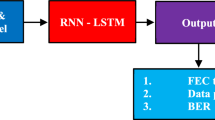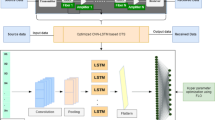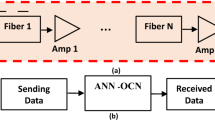Abstract
Multi-channel transmission mode is the mainstream in real optical system scenarios, and its precise prediction of the optical channel quality of transmission (QoT) can provide guidance for the connections routing and margins allocation, avoiding network resources waste and unavailable connection establishment. However, current multi-channel QoT predictions devote to single-step modeling. It is difficult to grasp the state changes of the optical channel for a period of time in the future, thereby hardly enabling early warnings for abnormal channel conditions and timely maintenance deployment. To tackle this issue, we propose a novel multi-step multi-channel QoT prediction framework, i.e., the deep echo state attention network (DESAN). Structurally, it consists of stacked reservoirs that are successively connected, supporting multi-level feature extraction of optical QoT signal. Specially, the attention mechanism (AM) is introduced for enhancing each reservoir’s state, which captures long-term QoT data features more effectively, meanwhile reducing the negative impact of redundant neurons as much as possible. Finally, aggregating the AM outputs of all reservoirs’ states is for the DESAN training. On the real-world optical-layer characteristic data from Microsoft optical backbone network, the simulation results show that our proposal can make a good tradeoff between sequential multi-step QoT modeling performance and efficiency. The statistical verification is further adopted to demonstrate our findings.






Similar content being viewed by others
Data availability
The datasets generated and/or analyzed during the current study are available from the corresponding author on reasonable request.
References
Imoize, A.L., Adedeji, O., Tandiya, N.: 6g enabled smart infrastructure for sustainable society: Opportunities, challenges, and research roadmap. Sensors 21(F5), 1709 (2021)
Ghobadi, M., Mahajan, R.: Optical layer failures in a large backbone. In: Proceedings of the 2016 Internet Measurement Conference, pp. 461–467 (2016)
Proietti, R., Chen, X., Zhang, K.: Experimental demonstration of machine-learning-aided qot estimation in multi-domain elastic optical networks with alien wavelengths. J. Opt. Commun. Netw. 11(1), 1–10 (2019)
Safari, P., Shariati, B., Bergk, G.: Deep convolutional neural network for network-wide qot estimation. In: 2021 Optical Fiber Communications Conference and Exhibition (OFC), pp. 1–3 (2021). IEEE
Ibrahimi, M., Abdollahi, H., Rottondi, C.: Machine learning regression for qot estimation of unestablished lightpaths. J. Opt. Commun. Netw. 13(4), 92–101 (2021)
Yan, S., Khan, F.N., Mavromatis, A.: Field trial of machine-learning-assisted and sdn-based optical network management. In: Optical Fiber Communication Conference, pp. 1–3 (2019). Optical Society of America
Seve, E., Pesic, J., Delezoide, C.: Learning process for reducing uncertainties on network parameters and design margins. J. Opt. Commun. Netw. 10(2), 298–306 (2018)
Sartzetakis, I., Christodoulopoulos, K.K., Varvarigos, E.M.: Accurate quality of transmission estimation with machine learning. J. Opt. Commun. Netw. 11(3), 140–150 (2019)
Gao, Z., Yan, S., Zhang, J.: Ann-based multi-channel qot-prediction over a 563.4-km field-trial testbed. J. Lightw. Technol. 38(9), 2646–2655 (2020)
Lu, Y., Tian, Z., Zhou, R.: Multi-step-ahead prediction of thermal load in regional energy system using deep learning method. Energy Build. 233, 1–11 (2021)
Fan, Q., Lu, J., Zhou, G.: Experimental comparisons between machine learning and analytical models for qot estimations in wdm systems. In: Optical Fiber Communication Conference, pp. 1–3 (2020). Optical Society of America
Abadi, M.M., Ghassemlooy, Z., Zvanovec, S.: Impact of link parameters and channel correlation on the performance of fso systems with the differential signaling technique. J. Opt. Commun. Netw. 9(2), 138–148 (2017)
Bai, J., Shen, Y., Xu, C.: Influence of inter-channel nonlinear interference on the qot estimation for elastic optical fiber networks. In: 2019 18th International Conference on Optical Communications and Networks (ICOCN), pp. 1–3 (2019). IEEE
Mata, J., De, M.I., Durán, R.J.: A svm approach for lightpath qot estimation in optical transport networks. In: 2017 IEEE International Conference on Big Data, pp. 4795–4797 (2017)
Rottondi, C., Barletta, L., Giusti, A.: Machine-learning method for quality of transmission prediction of unestablished lightpaths. J. Opt. Commun. Netw. 10(2), 286–297 (2018)
Panayiotou, T., Savva, G., Shariati, B.: Machine learning for qot estimation of unseen optical network states. In: Optical Fiber Communication Conference, pp. 1–3 (2019). Optical Society of America
D’Amico, A., Straullu, S., Nespola, A.: Machine-learning aided osnr prediction in optical line systems. In: 45th European Conference on Optical Communication (ECOC 2019), pp. 1–4 (2019). IET
Usmani, F., Khan, I., Masood, M.U.: Convolutional neural network for quality of transmission prediction of unestablished lightpaths. Microw. Opt. Technol. Lett. 63(10), 2461–2469 (2021)
Aladin, S., Tran, A.V.S., Allogba, S.: Quality of transmission estimation and short-term performance forecast of lightpaths. J. Lightw. Technol. 38(10), 2807–2814 (2020)
Zhang, Y., Zhang, Y., He, K., Li, D., Xu, X., Gong, Y.: Intelligent feature recognition for step-nc-compliant manufacturing based on artificial bee colony algorithm and back propagation neural network. J. Manuf. Syst. 62, 792–799 (2022)
Sun, X., Ma, S., Li, Y.: Enhanced echo-state restricted boltzmann machines for network traffic prediction. IEEE Internet Things J. 7(2), 1287–1297 (2019)
Gallicchio, C., Micheli, A., Pedrelli, L.: Design of deep echo state networks. Neural Netw. 108, 33–47 (2018)
Yan, C., Tu, Y., Wang, X., Zhang, Y., Hao, X., Zhang, Y., Dai, Q.: Stat: Spatial-temporal attention mechanism for video captioning. IEEE Trans. Multimedia 22(1), 229–241 (2019)
Zhou, Q., Liu, X., Wang, Q.: Interpretable duplicate question detection models based on attention mechanism. Inform. Sci. 543, 259–272 (2021)
He, X., Shi, S., Geng, X., Yu, J., Xu, L.: Multi-step forecasting of multivariate time series using multi-attention collaborative network. Expert Syst. Appl. 211, 118516 (2023)
Ahmed, T., Rahman, S., Ferdousi, S., Tornatore, M., Mitra, A., Chatterjee, B.C., Mukherjee, B.: Dynamic routing, spectrum, and modulation-format allocation in mixed-grid optical networks. J. Opt. Commun. Netw. 12(5), 79–88 (2020)
Wang, D., Jiang, H., Liang, G., Zhan, Q., Mo, Y., Sui, Q., Li, Z.: Optical performance monitoring of multiple parameters in future optical networks. J. Lightw. Technol. 39(12), 3792–3800 (2021)
Pointurier, Y.: Design of low-margin optical networks. J. Opt. Commun. Netw. 9(1), 9–17 (2017)
Zhang, L., Li, X., Tang, Y., Xin, J., Huang, S.: A survey on qot prediction using machine learning in optical networks. Opt. Fiber Technol. 68, 102804 (2022)
Zhang, C., Tian, X., Zhao, Y., et al.: Causal discovery-based external attention in neural networks for accurate and reliable fault detection and diagnosis of building energy systems. Building and Environment, 109357 (2022)
Elmaz, F., Eyckerman, R., Casteels, W.: Cnn-lstm architecture for predictive indoor temperature modeling. Build. Environ. 206, 108327 (2021)
Li, Q., Cheng, M., Wang, J., et al.: Lstm based phishing detection for big email data. IEEE Transactions on Big Data (2020)
Ur Rehman, S., Khaliq, M., Imtiaz, S.I.: Diddos: An approach for detection and identification of distributed denial of service (ddos) cyberattacks using gated recurrent units (gru). Future Generation Comp Syst 118, 453–466 (2021)
Zhang, M., Wang, B., Zhou, Y.: Woa-based echo state network for chaotic time series prediction. J. Korean Phys. Soc. 76(5), 384–391 (2020)
Xi, X., Jiang, W., Miran, S.M.: Feature extraction of surface electromyography based on improved small-world leaky echo state network. Neural Comput. 32(4), 741–758 (2020)
Li, Q., Wu, Z., Ling, R.: Multi-reservoir echo state computing for solar irradiance prediction: A fast yet efficient deep learning approach. Appl. Soft Comput. 95, 106481 (2020)
Acknowledgements
This work was supported in part by the key program of North China University of Science and Technology, under Grant No. ZD-YG-202317-23.
Author information
Authors and Affiliations
Corresponding author
Ethics declarations
Conflict of interest
On behalf of all authors, the corresponding author states that there is no conflict of interest.
Additional information
Publisher's Note
Springer Nature remains neutral with regard to jurisdictional claims in published maps and institutional affiliations.
Rights and permissions
Springer Nature or its licensor (e.g. a society or other partner) holds exclusive rights to this article under a publishing agreement with the author(s) or other rightsholder(s); author self-archiving of the accepted manuscript version of this article is solely governed by the terms of such publishing agreement and applicable law.
About this article
Cite this article
Sun, X., Cao, D., Hao, M. et al. Improving multi-step prediction performance of multi-channel QoT over optical backbone networks: deep echo state attention network. Opt Rev (2024). https://doi.org/10.1007/s10043-024-00873-9
Received:
Accepted:
Published:
DOI: https://doi.org/10.1007/s10043-024-00873-9




